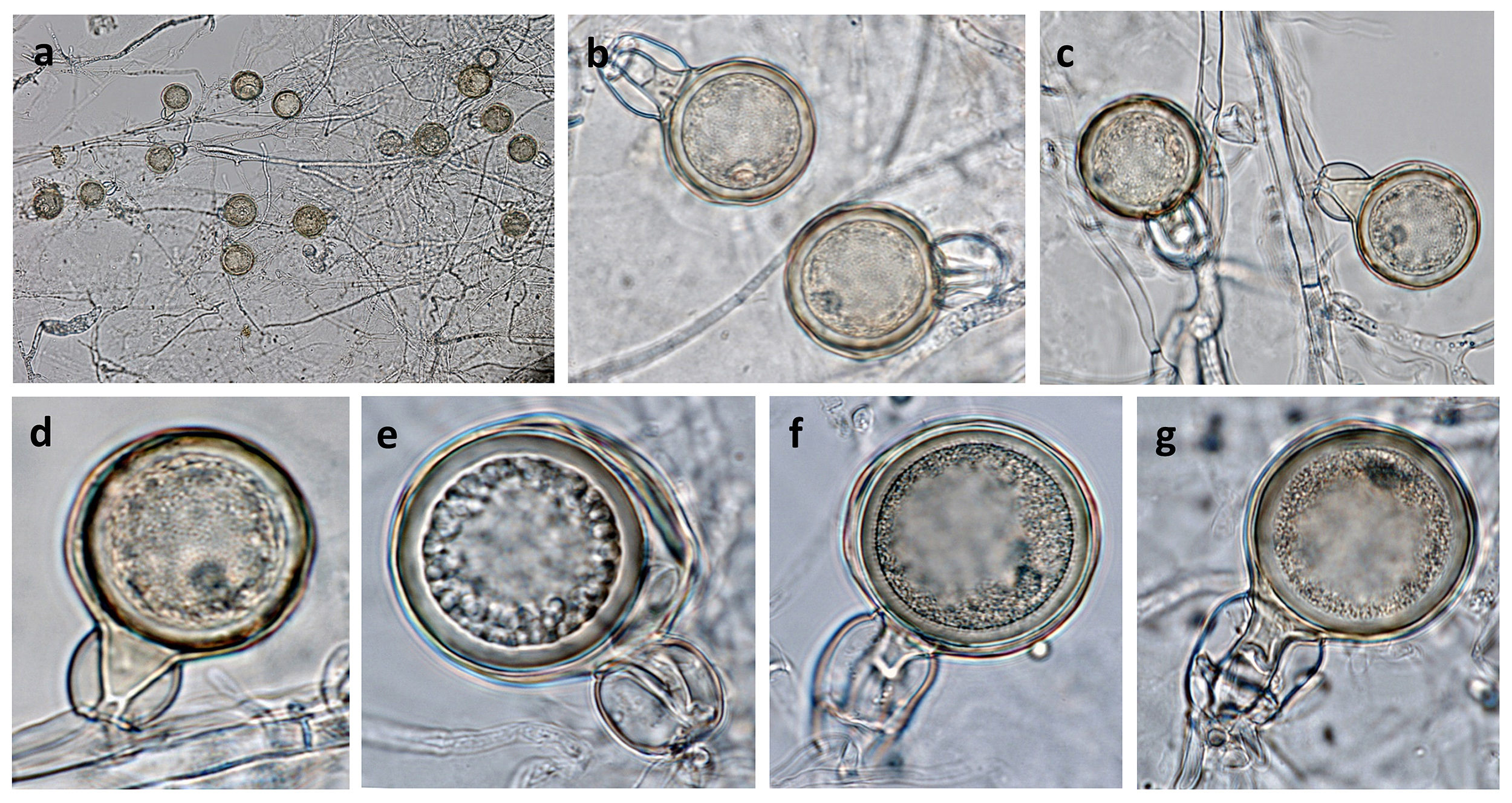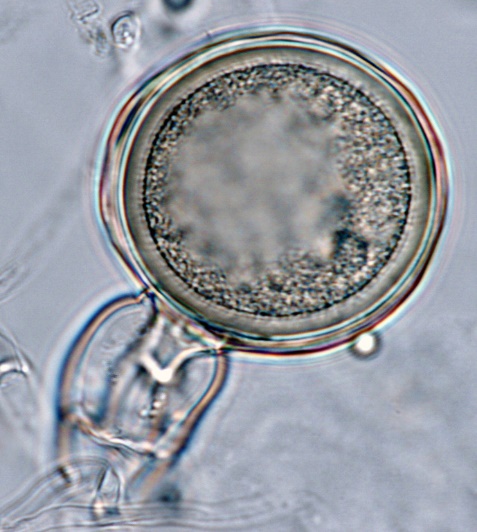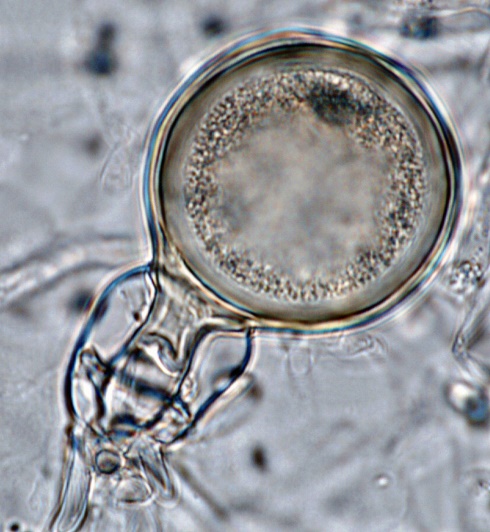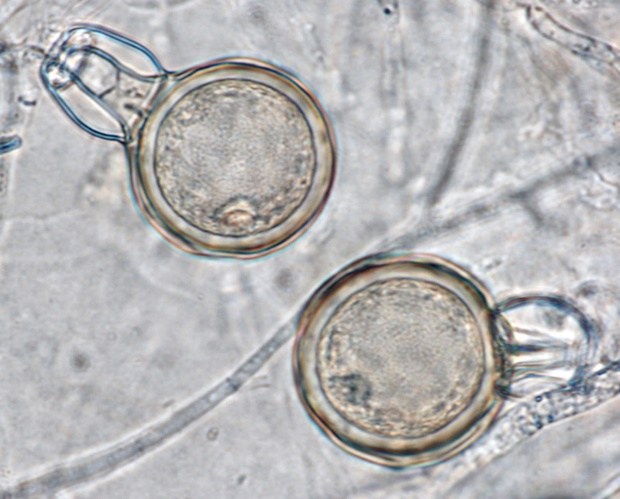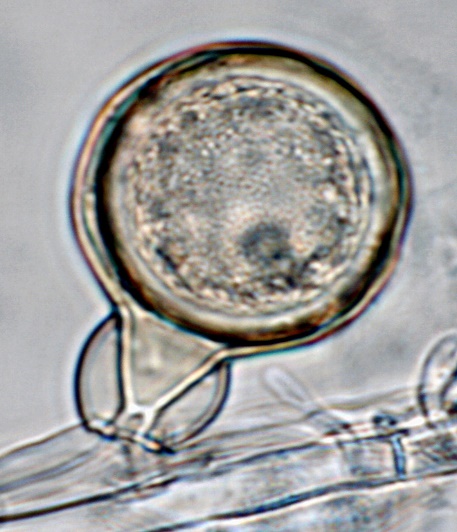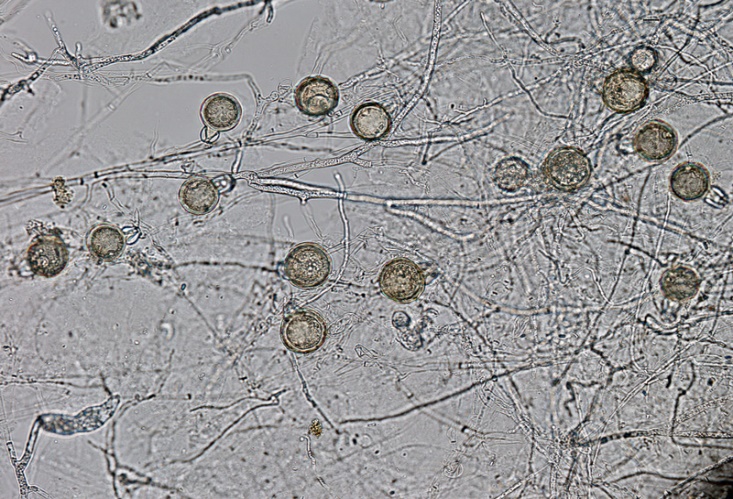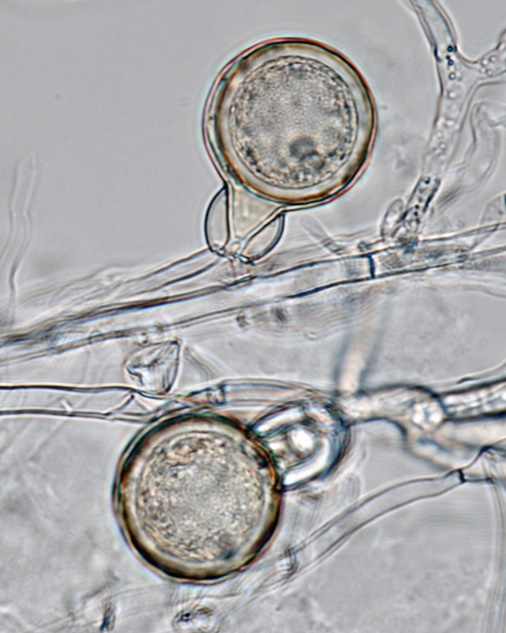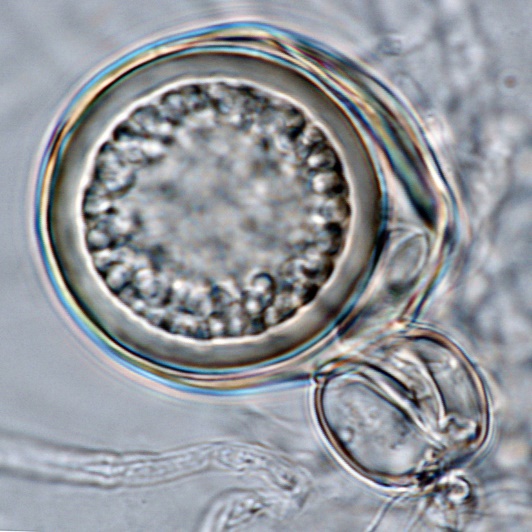Phytophthora uniformis (in progress - Abad et al. 2023b)
|
Phytophthora spp. in subclade 7a: portion of the seven-loci ML phylogeny featuring the type cultures of 212 described species (by T. Bourret). Notice the position of P. uniformis selected specimen CBS 149409 = S&T BL 3. Gloria Abad, USDA S&T.
|
|
Phytophthora spp. in subclade 7a: Morphological Tabular key (PDF) and Tabular key legends (PDF) in IDphy2 KEY SECTION. Notice the data of P. uniformis selected specimen CBS NRRL 64373 = S&T BL 3. Gloria Abad, USDA S&T.
|
|
Phytophthora alni subsp. uniformis (CPHST BL 3) colonies of the ex-type grown for 7 days on (a) V8® Agar, (b) potato dextrose agar, and (c) malt extract agar; photo by Krysta Jennings and Leandra Knight, USDA-APHIS-PPQ |
|
Phytophthora alni subsp. uniformis (CPHST BL 3) sexual phase of a selected specimen: (a-g) oogonia smooth-walled, or with slightly wavy-edged-verrucose; antheridia amphigynous, single- or two-celled (most common as in f-g); oospore predominantly plerotic (except in g); photos by Gloria Abad, USDA-APHIS-PPQ. |
|
Phytophthora alni subsp. uniformis (CPHST BL 3) sexual phase of a selected specimen: smooth-walled oogonium with slightly wavy-edge, predominatly plerotic; two-celled amphigynous antheridium; photo by Gloria Abad, USDA-APHIS-PPQ. |
|
Phytophthora alni subsp. uniformis (CPHST BL 3) sexual phase of a selected specimen: smooth-walled oogonium with slightly wavy-edge, predominatly plerotic; two-celled amphigynous antheridium; photo by Gloria Abad, USDA-APHIS-PPQ. |
|
Phytophthora alni subsp. uniformis (CPHST BL 3) sexual phase of a selected specimen: smooth-walled oogonia with slightly wavy-edges and amphigynous antheridia; photo by Gloria Abad, USDA-APHIS-PPQ. |
|
Phytophthora alni subsp. uniformis (CPHST BL 3) sexual phase of a selected specimen: smooth-walled oogonium with slightly wavy-edge and amphigynous antheridium; photo by Gloria Abad, USDA-APHIS-PPQ. |
|
Phytophthora alni subsp. uniformis (CPHST BL 3) sexual phase of a selected specimen: oospores with smooth-walled oogonia with slightly wavy-edges and amphigynous antheridia; photo by Gloria Abad, USDA-APHIS-PPQ. |
|
Phytophthora alni subsp. uniformis (CPHST BL 3) sexual phase of a selected specimen: smooth-walled oogonia with slightly wavy-edges and amphigynous antheridia; photo by Gloria Abad, USDA-APHIS-PPQ. |
|
Phytophthora alni subsp. uniformis (CPHST BL 3) sexual phase of a selected specimen: smooth-walled oogonium with a slightly wavy-edge and amphigynous antheridium; photo by Gloria Abad, USDA-APHIS-PPQ. |
Name and publication
Phytophthora alni subsp. uniformis Brasier & Kirk (2004)
Brasier CM, Kirk SA, Delcan J, Cooke DEL, and Jung T. 2004. Phytophthora alni sp. nov. and its variants: designation of emerging heteroploid hybrid pathogens spreading on Alnus trees. Mycol. Res. 108: 1172–1184.
Corresponding author: clive.brasier@forestry.gsi.gov.uk
Notes: reclassified as Phytophthora uniformis (Brasier & S.A. Kirk) Husson, Ioos & P. Frey (2015) (SMML). Reclassification under nomenclature evaluation.
Husson C, Aguayo J, Revellin C, Frey P, Ioos R, and Marcais B. 2015. Evidence for homoploid speciation in Phytophthora alni supports taxonomic reclassification in this species complex. Fungal Genet. Biol. 77: 12–21.
Phytophthora alni species complex (alder Phytophthora) Invasive Species Compendium
The alder Phytophthora species complex of oomycetes encompasses the hybrid P. × alni and its two parental species, P. uniformis and P. × multiformis.
Nomenclature
from Brasier et al. (2004)
Mycobank
Etymology
from uni and formis meaning of a more uniform phenotype
Typification
Type: SWEDEN, Gothenberg, isolated from Alnus bark, 1996, C. Olsson CH161 IMI 392315 (dried culture on carrot agar)
Ex-type: Isolate P875 at the Forestry Commission UK in Phytophthora culture collection
Sequences for ex-type in original manuscript: not provided
Selected specimen in other collections
(SE) CBS 149409, NRRL 64373, WPC P16206, S&T BL 3 (Abad), P875 (Brasier - DEFRA)
Molecular identification
Voucher sequences for barcoding genes (ITS rDNA and COI) of the selected specimen (see Molecular protocols page)
Phytophthora alni subsp uniformis isolate CPHST BL 3 ( = P16206) ITS rDNA MK496514, COI MH136992
Voucher sequences for Molecular Toolbox with seven genes (ITS, β-tub, COI, EF1α, HSP90, L10, and YPT1
(see Molecular protocols page) (In Progress)
Voucher sequences for Metabarcoding High-throughput Sequencing (HTS) Technologies [Molecular Operational Taxonomic Unit (MOTU)]
(see Molecular protocols page) (In Progress)
Sequences with multiple genes for selected specimen in other sources
- NCBI: Phytophthora alni subsp. uniformis CPHST BL 3
- NCBI: Phytophthora alni sub. sp. uniformis P16206
- EPPO-Q-bank: Phytophthora alni subsp. uniformis P875, PD 20019549
- BOLDSYSTEMS: Phytophthora alni subsp. alni
Position in multigenic phylogeny with 7 genes (ITS, β-tub, COI, EF1α, HSP90, L10, and YPT1)
Clade clade:
a taxonomic group of organisms classified together on the basis of homologous features traced to a common ancestor
7a
Morphological identification
adapted from Brasier et al. (2004)
Colonies and cardinal temperatures
Colonies in V8 agar, potato dextrose agar, and malt extract agar with no distinctive pattern and slow growth. Minimum growth temperature 3°C, maximum 30°C, and optimum 24–27°C.
Conditions for growth and sporulation
Sporangia produced sparsely in pea broth or when plugs from margins of actively growing cultures on V8-A or PDA are partially submerged in unsterile pond water or unsterile soil leachate.
Asexual phase
Sporangia nonpapillate, persistentpersistent:
pertaining to sporangia that remain attached to the sporangiophore and do not separate or detach easily (cf. caducous)
, ellipsoidellipsoid:
refers to a solid body that forms an ellipse in the longitudinal plane and a circle in cross section; many fungal spores are ellipsoidal or elliptic
, ovoidovoid:
egg-shaped, with the widest part at the base of the sporangium and the narrow part at the apex
, obovoidobovoid:
inversely egg-shaped; ovoid, but with the widest part at the apex
, obpyriformobpyriform:
inversely pear-shaped, i.e. with the widest part at the point of attachment (cf. pyriform)
(28–69 µm length,17–42 µm width) showing internal proliferationinternal proliferation:
internal proliferation occurs when the sporangiophore continues to grow through an empty sporangium
and borne single in long sporangiophores. Hyphal swellings absent. ChlamydosporesChlamydospores:
an asexual spore with a thickened inner wall that is delimited from the mycelium by a septum; may be terminal or intercalary, and survives for long periods in soil
absent.
Sexual phase
Homothallic. OogoniaOogonia:
the female gametangium in which the oospore forms after fertilization by the antheridium
mostly smooth-walled, but some slightly wavy-edged (verrucose). Occasionally, oogoniaoogonia:
the female gametangium in which the oospore forms after fertilization by the antheridium
have large, distorted beak-like protuberances (37.5–55 µm wide). AntheridiaAntheridia:
the male gametangium; a multinucleate, swollen hyphal tip affixed firmly to the wall of the female gametangium (the oogonium)
amphigynousamphigynous:
pertaining to the sexual stage in which the antheridium completely surrounds the stalk of the oogonium (cf. paragynous)
and consistently two-celled. The antheridial cross-wall is often close to the base of the antheridiumantheridium:
the male gametangium; a multinucleate, swollen hyphal tip affixed firmly to the wall of the female gametangium (the oogonium)
and can be overlooked. Oosporeoospore:
zygote or thick-walled spore that forms within the oogonium after fertilization by the antheridium; may be long-lived
plerotic (overall range ca 30–47.5 µm).
Most typical characters
P. alni subsp. uniformis produces oogoniaoogonia:
the female gametangium in which the oospore forms after fertilization by the antheridium
with a smooth surface and some with slightly wavy edge (verrucose).
Additional specimen(s) evaluated
P. alni subsp. uniformis CPHST-BL # 3 (Abad) = P16206 [World Phytophthora Collection (WPC) California, USA] duplicate of the ex-type P875 Brasier
P. alni subsp. uniformis Abad S511 from Alaska
Hosts and distribution
Distribution: France, Spain, Belgium, Slovenia, USA (Alaska and Oregon)
Substrate: stem/roots
Disease note: root and collar rot
Hosts: Alnus spp. (alder, black alder)
Retrieved January 19, 2018 from U.S. National Fungus Collections Nomenclature Database.
Additional references and links
Adams GC, Catal M, Trummer L, Hansen EM, Reeser P, and Worrall JJ. 2008. Phytophthora alni subsp. uniformis found in Alaska beneath thinleaf alders. Online. Plant Health Progress doi:10.1094/PHP-2008-1212-02-BR. http://www.forestpathology.org/pdfs/adams2008Palni.pdf
Aguayo J, Adams GC, Halkett F, Catal M, Husson C, Nagy ZA, Hansen EM, Marçais B, and Frey P. 2013. Strong genetic differentiation between North American and European populations of Phytophthora alni subsp. uniformis. Phytopathology 103: 190–199.
Bakonyi J, Nagi ZA, and Ersek T. 2006. PCR-based DNA markers for identifying hybrids within Phytophthora alni. Journal of Phytopathology 154: 168–177. http://dx.doi.org/10.1111/j.1439-0434.2006.01079.x
Ioos, R., Andrieux, A., Marcais, B., & Frey, P. 2006. Genetic characterization of the natural hybrid species Phytophthora alni as inferred from nuclear and mitochondrial DNA analyses. Fungal Genetics and Biology 43:511–529.
Ioos R, Andrieux A, Marcais B, and Frey P. 2007. New hypothesis on the origin of the interspecific hybrid Oomycete Phytophthora alni. Pages 61–62. in: Fourth Meeting of the IUFRO Working Party S07.02.09 EM Goheen and SJ Frankel, eds. USDA-FS PSW-GTR-221, Monterey, CA, August, 26, 2007.
Pintos Varela C, Rial Martínez C, Aguín Casal O, Mansilla Vázquez JP, and Ares Yebra A. 2012. First report of Phytophthora alni subsp. uniformis on black alder in Spain. Plant Disease 96: 589 http://apsjournals.apsnet.org/doi/abs/10.1094/PDIS-10-11-0891-PDN
Sims L, Navarro S, and Hansen EM. 2012. Phytophthora species isolated from Alnus rubra in western Oregon riparian ecosystems. Proceedings of the 6th Meeting of the International Union of Forest Research Organizations (IUFRO) Working Party S07-02-09 September 9–14, 2012, Còrdoba, Spain. Pg. 46
Winton L. 2012. Phytophthora alni subsp. uniformis) in Alaska
- SMML USDA-ARS: Phytophthora uniformis
- EPPO Global Database: Phytophthora uniformis
- Forest Phytophthoras of the world: Phytophthora uniformis
- CABI Digital Library: Phytophthora uniformis
- Encyclopedia of Life (EOL): Phytophthora uniformis
- Index Fungorum (IF): Phytophthora alni subsp. uniformis 488624
- Google All Phytophthora alni subsp. uniformis
- Google Images Phytophthora alni subsp. uniformis
- Google Scholar Phytophthora alni subsp. uniformis
Fact sheet author
Z. Gloria Abad, Ph.D., USDA-APHIS-PPQ-S&T Plant Pathogen Confirmatory Diagnostics Laboratory (PPCDL), United States of America.

.jpg)
